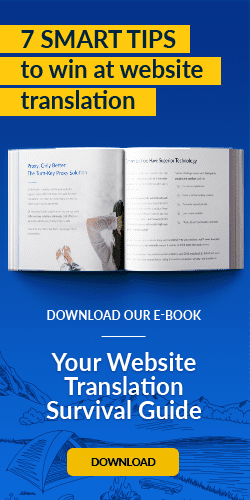Localized multimedia content plays an important role in web design, digital marketing and e-commerce. In fact, it’s the first thing your global customers see when they visit your multilingual websites.
But undercooked website translation solutions rarely—if ever—translate this mission-critical content. That can instantly wreck your brand’s credibility. Content often overlooked by these “solutions” includes:
- Images (graphics that contain embedded text)
- Videos
- Interactive applications
- PDFs
- And more
Ignoring this mission-critical creates a jarring, “mixed language” online experience, alienates customers and poses risks to your brand.
What’s at Stake?
Untranslated multimedia assets send the wrong signal to your international customers. Ultimately, it suggests they’re not worth the investment of a fully-immersive, fully translated experience. It’s bad optics.
Customers don’t take such slights lightly.
Most will bounce from your site. Some may never return. No brand can afford to lose customers—especially in the early days of serving them in their markets.
Detecting an Incomplete Solution
Which website translation solutions are up to the challenge? There are ways to tell when a translation solution is inadequate. Before signing on the dotted line, determine if the vendor suffers from one or more of these shortcomings:
- Offering translation of on-site text only, with no multimedia translation.
- An inability to identify translatable multimedia assets at all.
- Separating text and multimedia content for translation. (This isn’t a best practice; translators need to see how these elements interplay visually on the web page.)
- Identifying images for translation without supporting the translation itself or its related production tasks.
- An inability to translate interactive applications.
Best Practices
When choosing a translation solution, come armed knowing these best practices for content detection, images, and more:
Content Detection
It’s critical to choose a solution that can not only recognize translatable multimedia content, but also efficiently route each asset to translators and designers for production.
And you shouldn’t have to tell the vendor where your translatable content “lives” on a server or CMS. The vendor’s content-parsing and change-detection technologies should automatically identify new or updated content, and its online location.
Images
Ask your vendor for examples of translated images. Any copy must be in-language, while maintaining the brand’s existing corporate identity. The translated image should look like it was created by whomever created the original asset.
It should also be culturally sensitive, featuring regionally-relevant people in photos—when relevant.
Tip: Do not embed text in graphics. Instead, overlay text within the HTML.
Rapid translation turnaround is imperative. For translating images, a service-level agreement of about one business day is a best practice.
Video
Ask your translation vendor about its experience localizing videos. Great vendors should know when to use subtitles rather than dubbing.
And when it comes to localizing subtitles, look for a vendor with expertise in creating dynamically-loaded subtitles that “live” outside a digital video but is loaded when the video plays. These subtitles display at the right time on-screen, without having to be embedded into the actual video.
Interactive Applications
Great vendors can parse translatable content from the code of interactive applications.
No matter what the code language is—AngularJS, JavaScript, JSON, and more—great content-parsing technology enables designers to easily localize these experiences.
Source Files
Does the vendor expect you to provide “source” files (such as Photoshop PSDs) for translation? You shouldn’t have to. Technologies exist that enable skilled designers to localize these assets with relative ease.
Great vendors never ask you for source files to localize your multimedia content.
First Impressions Matter
They say a picture’s worth a thousand words, but if your image has untranslated text, it’s worth nothing to that customer. Make every word, image and video count for those meeting your brand for the first time. Deliver an immersive, in-language user experience to help your company meet customer expectations and build brand credibility.
Last updated on October 26, 2017
